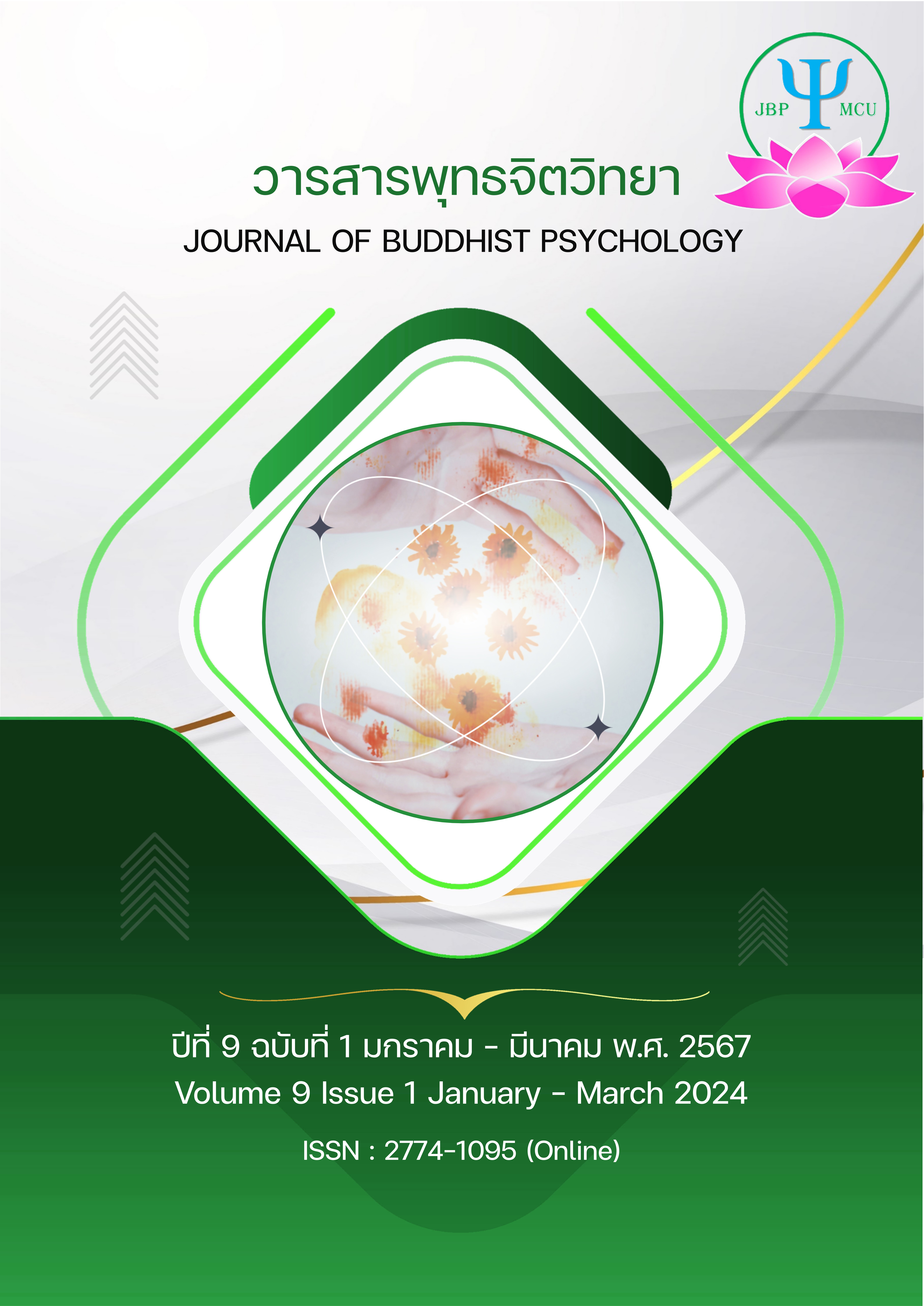A study of Potential of Religious Tourism Destinations in Phayao Province
Main Article Content
Abstract
The purpose of this research is to study the potential of religious tourism destinations in Mueang District, Phayao Province. The sample group consisted of 400 Thai tourists who were selected as the sample group using random sampling. The research instrument used was a questionnaire. The data were analyzed using descriptive statistics.
The potential of religious tourism in Phayao Province is generally rated as high, with an average score of 3.53. When considering specific aspects, it is evident that Thai tourists hold the highest opinions regarding the environment aspects, with a significantly high average score of 3.75. The next aspect is the touristic value and charm, with a high average score of 3.66. The aspect with the lowest rating is public participation, although it still has a relatively high average score of 3.42. Religious tourist attractions hold significant value for the local community. They serve as places of worship, deeply embedded in the spirit of the community, and they encourage community members to appreciate the essence of Buddhism. Religious tourist attractions also provide career opportunities and sources of income for people in the local community. Moreover, improvements in accessibility and facilities at these attractions are needed to better accommodate visitors. Community engagement is crucial, and it has been observed that residents are eager to welcome tourists. They have found opportunities to increase their income through tourism by selling products and providing services to visitors. Moreover, religious tourism destinations should adopt modern and diverse public relations channels, particularly leveraging social media platforms like Facebook and Line for quick and cost-effective communication.
Article Details

This work is licensed under a Creative Commons Attribution-NonCommercial-NoDerivatives 4.0 International License.
References
กระทรวงการท่องเที่ยวและกีฬา. (2565). สถิตินักท่องเที่ยวภายในประเทศ Q1-Q4 ปี 2564 (ภาคเหนือ). สืบค้นเมื่อ 5 ตุลาคม 2566, จาก http://binfo.onab.go.th/Temple/Dashboard.aspx
จิรานุช โสภา และคณะ. (2554). ศักยภาพการจัดการแหล่งท่องเที่ยวเมืองมรดกโลก ของประเทศไทย กรณีศึกษ : อุทยานประวัติศาสตร์สุโขทัย-ศรีสัชนาลัย
กำแพงเพชรและอุทยานประวัติศาสตร์พระนครศรีอยุธยาเพื่อการท่องเที่ยว เชิงวัฒนธรรมอย่างยั่งยืน (รายงานวิจัย). มหาวิทยาลัยราชภัฏสวนดุสิต.
ธีรพัฒน์ ตื้อตัน. (2546). ความรู้ ทัศนคติ และการมีส่วนร่วมของประชาชนต่อการจัดการการท่องเที่ยวเชิงนิเวศ ในพื้นที่วนอุทยานม่อนพระยาแช่ ตำบลพิชัย อำเภอเมือง จังหวัดลำปาง (วิทยานิพนธ์วิทยาศาสตรมหาบัณฑิต). มหาวิทยาลัยเกษตรศาสตร์.
ธีรวุฒิ เอกะกุล. (2543). ระเบียบวิธีวิจัยทางพฤติกรรมศาสตร์และสังคมศาสตร์. อุบลราชธานี: สถาบันราชภัฏอุบลราชธานี.
พระจำนงค์ ผมไผ และ คณะ. (2563). วัดกับการส่งเสริมการท่องเที่ยวบนเส้นทางลุ่มน้ำโขง.วารสารสังคมศาสตร์และมานุษยวิทยาเชิงพุทธ, 5(5), 158-170.
พระไพฑูรย์ อารัมภรัตน์. (2556). การมีส่วนร่วมของประชาชนต่อกิจกรรมทางพุทธศาสนากรณีศึกษา เขตทวีวัฒนา จังหวัดกรุงเทพมหานคร. Veridian E-Journal, SU, 6(1), 457-478.
ยุทธศักดิ์ สุภสร. (2563). การนำเสนอทิศทาง การส่งเสริมการท่องเที่ยว ของ ททท. ปี 2563. สืบค้นเมื่อ 5 ตุลาคม 2566, จาก https://tatreviewmagazine.com/article/tourism-direction-2020/
วิวัฒน์ชัย บุญยภักดิ์. (2529). แนวคิดด้านศักยภาพของแหล่งท่องเที่ยว ผลกระทบของอุตสาหกรรมท่องเที่ยวต่อมรดกศิลปวัฒนธรรม. จุลสารการท่องเที่ยว, 40-42.
ศิวนิต อรรถวุฒิกุลและคณะ. (2560). การพัฒนารูปแบบการจัดการการท่องเที่ยวเชิงศาสนาของจังหวัดราชบุรี. Veridian E-Journal, Silpakorn University สาขามนุษยศาสตร์ สังคมศาสตร์ และศิลปะ, 10(2), 2392-2409.
สมชาย สนั่นเมือง. (2540). แนวทางการพัฒนาแหล่งท่องเที่ยว. กรุงเทพฯ: ดอกหญ้า.
สำนักงานพระพุทธศาสนาแห่งชาติ. (2564). ระบบทะเบียนวัด. สืบค้นเมื่อ 5 ตุลาคม 2566, จาก http://binfo.onab.go.th/Temple/Dashboard.aspx
สุวรรณา มุ่งเจริญ. (2555). การจัดการท่องเที่ยวเชิงศาสนา กรณีศึกษา อุทยานศาสนาพระโพธิสัตว์กวนอิม จังหวัดเพชรบุรี (วิทยานิพนธ์ศิลปศาสตรมหาบัณฑิต). มหาวิทยาลัยศิลปากร.
เอกนรินทร์ ปันยานะ. (2547). มาตรการรักษาความปลอดภัยให้กับนักท่องเที่ยวจากต่างประเทศ: ศึกษากรณีสำนักงานตรวจคนเข้าเมือง สำนักงานตำรวจแห่งชาติ (รายงานการวิจัย). สำนักงานเลขาธิการวุฒิสภา.
Dickman, S. (1996). Tourism: An introductory text (2nd ed.). Sydney: Hodder Education.
Ivanovic, M., Khunou, R., Pawson, T., Reynish, N., Tseane, L., & Wassung, N. (2009). Fresh perspectives: Tourism Development. Cape Town : Pearson.
Middleton, V.T.C. (1994). Marketing in Travel and Tourism. 2nd ed. Oxford: Heinemann Prifessional Publishing.
World Tourism Organization (UNWTO). (2018). Why tourism?. Retrieved September 29, 2023, from http://www2.unwto.org/content/ why-tourism.
Yamane, T. (1973). Statistics: an introductory analysis. New York: Harper& Row.


